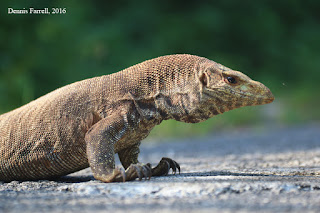Number: 187
Family: Coenagrionidae
Genus: Aciagrion
Species: Aciagrion sp. (possibly A. occidentale)
Common name(s): N/A
Synonyms: N/A
Habitat: Forested pond
Province(s) sighted: Phu Khieo Wildlife Sanctuary (Chaiyaphum)
Sightings (by me): 3-4 males spotted at one natural pond
In flight (that I have seen): October
Species easily confused with: All Aciagrion species
Tiny, blue and all look the same! Talk to any dragonfly lover about Aciagrion and they instantly wince. It is an incredibly difficult and confusing genus that needs to be resolved - though anyone who dares to do it is a brave individual indeed. There are several known species in Thailand, though one or two of them could have been misidentified (possibly even by the original authors). That said, it seems that there are possibly several more out there that are yet to be described. One of which, I may have spotted last week. It is an Aciagrion species that seems to fall between A. hisopa and A. borneense with a sprinkling of A. pallidum thrown in for good measure. Superficially, it looks like A. borneense. However, the striking difference is the solid blue patch on the abdomen (save a tiny "v" nick) and the appendages are white. The colouration of the rest of the male seems to match that of A. borneense. If it was the only specimen, then I would possibly put it down to being a slightly different population of A. borneense. However, through Dragonflies of Thailand (on Facebook), it appears that this species (with exacting markings) has been spotted at several locations throughout Thailand, though is scarce or overlooked. Also, looking back through my records (old photos) it appears that I did spot a young male (very pale but with a solid patch) at Nam Nao a couple of winters ago. Unfortunately, I was unable to catch one (I saw 3-4 males at one location) as I had forgotten my net. I will return to try and collect a specimen. For now, however, it can only be known at Aciagrion species - until someone far braver than me takes up the horrible and extremely confusing Aciagrion gauntlet and goes back to the drawing board with this genus. Probably not in my lifetime though haha.
The 'new' Aciagrion species (to add even more confusion to the boiling Aciagrion pot):
1. This one taken at Nam Nao a few years back I first though was A. borneense, but you can just make out the markings (which are similar to that of the specimen above), though this could even be A. occidenale aaarrrggghh!!!)
2. A pallidum, a common winter species (here, this male has whitish appendages...
4. A. hisopa - similar to the 'new' species but completely blue (no green) and the ocelli (eye spots) are large. Also, from memory, it is slightly larger too.
So, there you have it. Aciagrion is as clear as mud! Over to the experts.
Tiny, blue and all look the same! Talk to any dragonfly lover about Aciagrion and they instantly wince. It is an incredibly difficult and confusing genus that needs to be resolved - though anyone who dares to do it is a brave individual indeed. There are several known species in Thailand, though one or two of them could have been misidentified (possibly even by the original authors). That said, it seems that there are possibly several more out there that are yet to be described. One of which, I may have spotted last week. It is an Aciagrion species that seems to fall between A. hisopa and A. borneense with a sprinkling of A. pallidum thrown in for good measure. Superficially, it looks like A. borneense. However, the striking difference is the solid blue patch on the abdomen (save a tiny "v" nick) and the appendages are white. The colouration of the rest of the male seems to match that of A. borneense. If it was the only specimen, then I would possibly put it down to being a slightly different population of A. borneense. However, through Dragonflies of Thailand (on Facebook), it appears that this species (with exacting markings) has been spotted at several locations throughout Thailand, though is scarce or overlooked. Also, looking back through my records (old photos) it appears that I did spot a young male (very pale but with a solid patch) at Nam Nao a couple of winters ago. Unfortunately, I was unable to catch one (I saw 3-4 males at one location) as I had forgotten my net. I will return to try and collect a specimen. For now, however, it can only be known at Aciagrion species - until someone far braver than me takes up the horrible and extremely confusing Aciagrion gauntlet and goes back to the drawing board with this genus. Probably not in my lifetime though haha.
The 'new' Aciagrion species (to add even more confusion to the boiling Aciagrion pot):
For comparison, here are photos similar species (where - though subtle - you can make out differences):
1. This one taken at Nam Nao a few years back I first though was A. borneense, but you can just make out the markings (which are similar to that of the specimen above), though this could even be A. occidenale aaarrrggghh!!!)
2. A pallidum, a common winter species (here, this male has whitish appendages...
...or an even more confusing blue colour (though this could be another species!!!)
3. A. borneense - here you can clearly see the typical markings which make ID possible - very different than the new species. Easily the most common species.4. A. hisopa - similar to the 'new' species but completely blue (no green) and the ocelli (eye spots) are large. Also, from memory, it is slightly larger too.
5. Just for good measure, here is A. approximans, another fairly common uplands species to add to the mix (though fairly easy to separate with its purplish hues).
So, there you have it. Aciagrion is as clear as mud! Over to the experts.






























